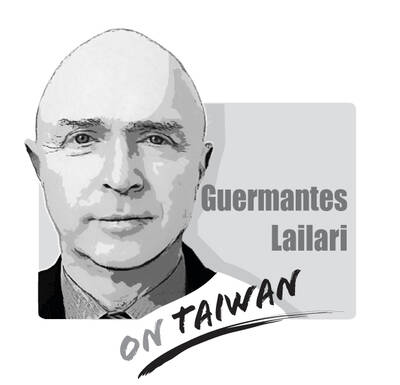In the animal kingdom and the world of insects, perhaps the easiest way to distinguish one species from another, beyond the external form, is to look at their DNA or listen to the sounds they make. The meow of the cat is, for example, worlds apart from the dog’s bark.
In the world of politics, if one seeks to differentiate one party from another, aside from the parties’ names, the most important way to tell the difference is each respective party’s policies, ideas and trajectories.
On the surface, the Chinese Nationalist Party (KMT) and the Chinese Communist Party (CCP) go by different names and seem not to resemble one another when viewed from a distance. Just as with rabbits, when the buck and doe are stationary, they are easy to tell apart, but when they run, they are virtually indistinguishable, so it is with the KMT and the CCP.
Outside of election season, the two parties share many similarities. During election season, the similarities stand out all the more. What DNA exactly do they share?
For starters, they are both political parties with the word “Chinese” in their names.
Second, they were both founded in China.
Third, early leaders and members of both cut their teeth and were trained at the Whampoa Military Academy, with examples being former president Chiang Kai-shek (蔣介石), who served as the academy’s first commandant, and former Chinese premier Zhou Enlai (周恩來), who was an instructor.
Next, they both promote concepts such as the “one China principle,” “one country, two systems” and the “1992 consensus.” All of these ideas say that Taiwan is a part of China, and although they try to dress the idea up in different ways, they are all essentially saying the same thing. The KMT promotes the idea of the so-called “1992 consensus” — supposedly a tacit agreement between the CCP and KMT that they both agree on the principle of “one China,” but agree to disagree on what “China” means — which was never a consensus.
However, in doing so, the KMT falls into the trap of the preamble of the Constitution of the People’s Republic of China, which says that “Taiwan is part of the sacred territory of the People’s Republic of China.”
They both oppose “Taiwanese independence.” Yet no specific definition is ever given for what constitutes Taiwanese independence — whether saying the Republic of China (ROC) or Taiwan is not part of China, or electing a president by about 23 million Taiwanese — all can be viewed as Taiwanese independence.
However, the presidential election is the most powerful demonstration that the ROC or Taiwan is already an independent country with its own voters and territory, which does not include China.
Also, they both hope the KMT presidential candidate will be elected tomorrow. This is because the Democratic Progressive Party (DPP) has always opposed the CCP and seems to be pro-US and anti-communist. On the other hand, the KMT often views the situation from the CCP’s perspective and acts pro-China and anti-US.
Lastly, they both deny that the CCP is interfering in Taiwan’s elections.
The KMT and the CCP share several similarities, including their political approaches, stances and direction. They even originated from the same place and support the same presidential candidate.
When they sound so identical, it is no wonder it is so hard to discern one from the other, and easy to believe that these creatures have identical DNA.
Chuang Sheng-rong is a lawyer.
Translated by Chien Yan-ru
A response to my article (“Invite ‘will-bes,’ not has-beens,” Aug. 12, page 8) mischaracterizes my arguments, as well as a speech by former British prime minister Boris Johnson at the Ketagalan Forum in Taipei early last month. Tseng Yueh-ying (曾月英) in the response (“A misreading of Johnson’s speech,” Aug. 24, page 8) does not dispute that Johnson referred repeatedly to Taiwan as “a segment of the Chinese population,” but asserts that the phrase challenged Beijing by questioning whether parts of “the Chinese population” could be “differently Chinese.” This is essentially a confirmation of Beijing’s “one country, two systems” formulation, which says that

“History does not repeat itself, but it rhymes” (attributed to Mark Twain). The USSR was the international bully during the Cold War as it sought to make the world safe for Soviet-style Communism. China is now the global bully as it applies economic power and invests in Mao’s (毛澤東) magic weapons (the People’s Liberation Army [PLA], the United Front Work Department, and the Chinese Communist Party [CCP]) to achieve world domination. Freedom-loving countries must respond to the People’s Republic of China (PRC), especially in the Indo-Pacific (IP), as resolutely as they did against the USSR. In 1954, the US and its allies
Indian Prime Minister Narendra Modi arrived in China yesterday, where he is to attend a summit of the Shanghai Cooperation Organization (SCO) with Chinese President Xi Jinping (習近平) and Russian President Vladimir Putin today. As this coincides with the 50 percent US tariff levied on Indian products, some Western news media have suggested that Modi is moving away from the US, and into the arms of China and Russia. Taiwan-Asia Exchange Foundation fellow Sana Hashmi in a Taipei Times article published yesterday titled “Myths around Modi’s China visit” said that those analyses have misrepresented India’s strategic calculations, and attempted to view
When Chinese President Xi Jinping (習近平) stood in front of the Potala Palace in Lhasa on Thursday last week, flanked by Chinese flags, synchronized schoolchildren and armed Chinese People’s Liberation Army (PLA) troops, he was not just celebrating the 60th anniversary of the establishment of the “Tibet Autonomous Region,” he was making a calculated declaration: Tibet is China. It always has been. Case closed. Except it has not. The case remains wide open — not just in the hearts of Tibetans, but in history records. For decades, Beijing has insisted that Tibet has “always been part of China.” It is a phrase